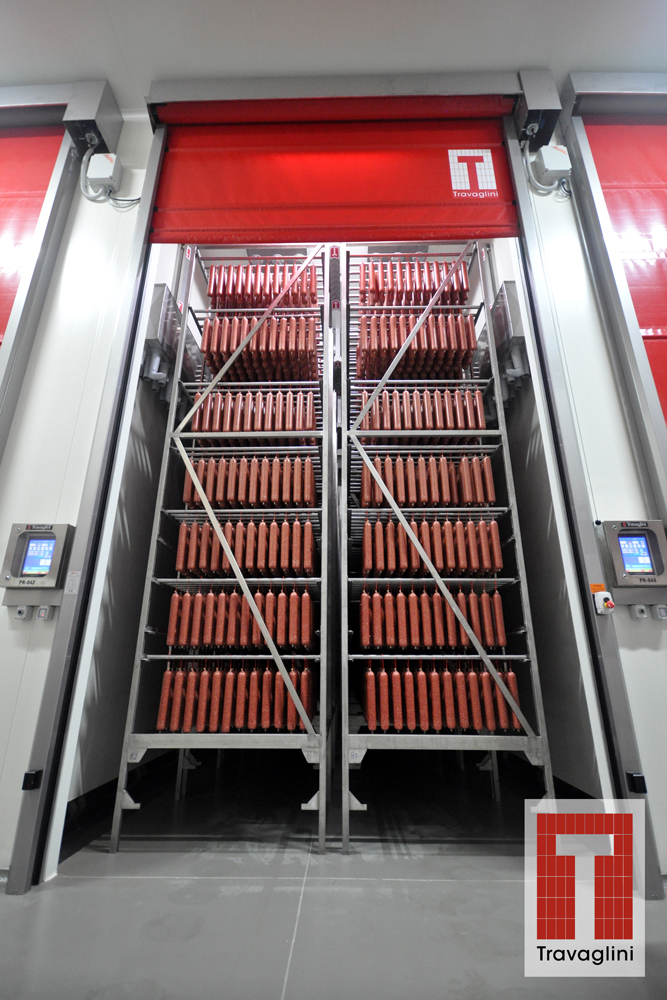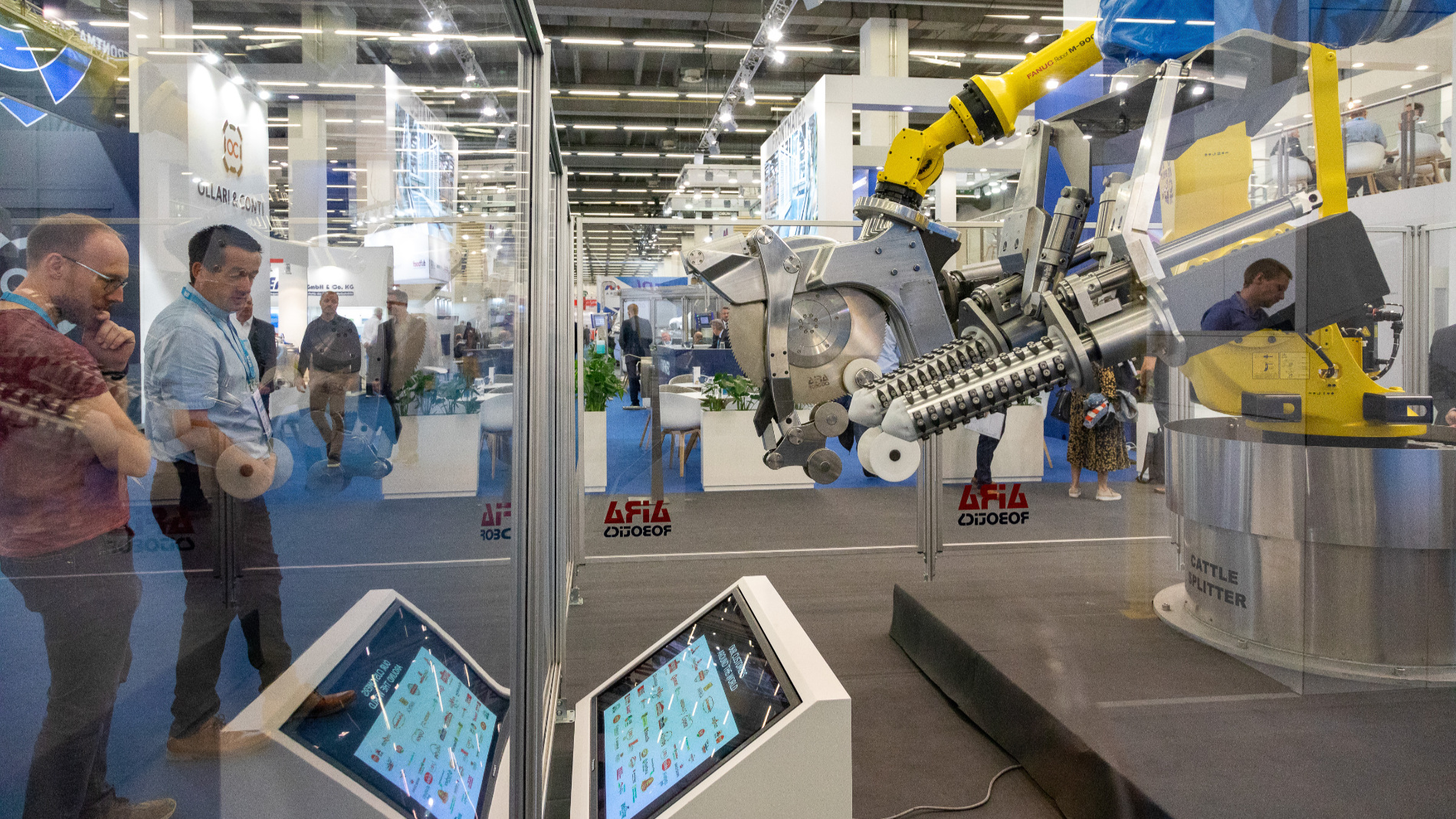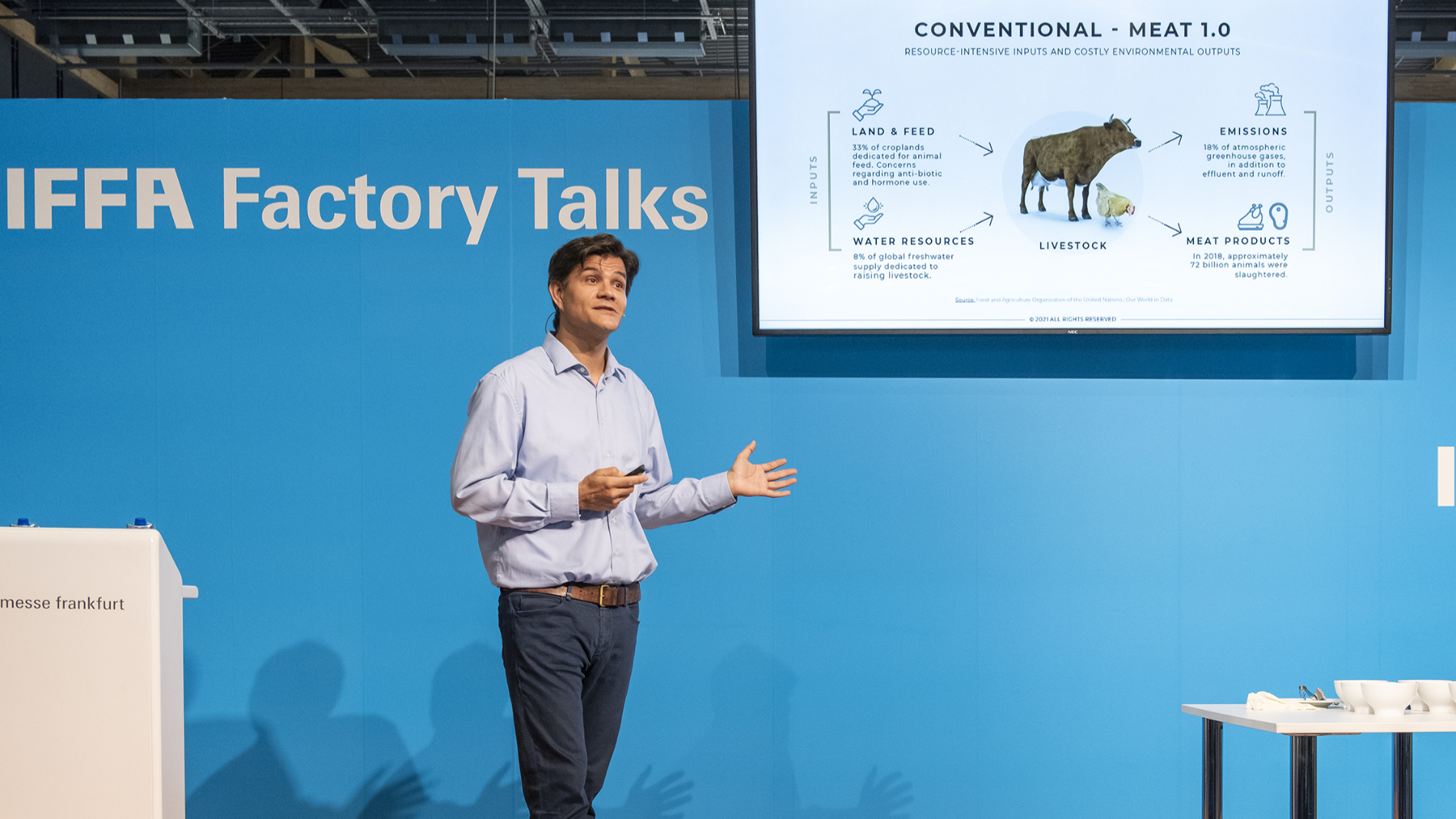Internationale Suchmaschine für Technologien für Fleisch und alternative Proteine
Stand: Aussteller IFFA 2025
TRAVAGLINI S.p.A.

Adresse
TRAVAGLINI S.p.A.
Via De Vizzi Viganò 86
20092 Cinisello Balsamo Milano
Italien
Telefon+39 02 660971
Fax+39 02 6601 3999
Entdecken Sie mehr von uns
Über uns
Seit 1950 sind wir der Marktführer im Bau von Anlagen für die Fermentierung, das Räuchern und für die Nachreifung von Fleischprodukten.
Unser Kerngeschäft ist die Auslegung und Produktion von Anlagen mit folgenden Aufgabenschwerpunkten:
Fermentierungs-(Vorreife-), Rauch- und Nachreifeanlagen für die Herstellung von Rohwurst- und Rohschinkenprodukten;
Reinraumsystem sowie Luftbehandlungsanlagen für Arbeitsbereiche;
Garanlagen für die Mortadellaproduktion;
Auftauanlagen für Fleisch und andere Lebensmittel;
Pasteurisierungsanlagen, Spiralfroster und Gefriertunnel;
Kühlanlagen mit umweltfreundlichem Frigen, Ammoniak oder Glycol;
- Klimatisierungslinien für die Fisch- und Käseproduktion.
Dank unserer langjährigen Erfahrung sind wir in der Lage jegliche Anforderungen aus der Produktion zu erfüllen. Unabhängig ob es dabei um die Auslegung und Anpassung einzelner Maschinen geht oder die Planung ganzer Betriebe ansteht, es werden immer die modernsten Erkenntnisse aus Technologie und Informatik zum Einsatz gebracht.
Über die Jahre hinweg haben wir einen effizienten Kundenservice entwickelt der sich auf alle Projektschritte erstreckt, inklusive der Betreuung nach dem Verkauf. Wir sind direkt verantwortlich für die Montage, Inbetriebnahme und Wartung der weltweit gelieferten Travaglini Systeme.
Aufbauend auf unserem hochqualifizierten Service sind wir in der Lage unseren Kunden neue Produktionstechnologien anzubieten und sie bei der Lösung jeglicher Art von Produktionsproblemen zu begleiten.
Die ständige Anwesenheit unserer Spezialisten in den Fabrikanlagen unserer Kunden garantiert die Erforschung und Entwicklung immer noch höher entwickelter Technologien. Dafür ist TRAVAGLINI weltweit bekannt und unsere Kunden sind unsere beste Referenz.
Travaglini S.p.A.ist zertifiziert UNI EN ISO 9001:2015.
Unser Kerngeschäft ist die Auslegung und Produktion von Anlagen mit folgenden Aufgabenschwerpunkten:
Fermentierungs-(Vorreife-), Rauch- und Nachreifeanlagen für die Herstellung von Rohwurst- und Rohschinkenprodukten;
Reinraumsystem sowie Luftbehandlungsanlagen für Arbeitsbereiche;
Garanlagen für die Mortadellaproduktion;
Auftauanlagen für Fleisch und andere Lebensmittel;
Pasteurisierungsanlagen, Spiralfroster und Gefriertunnel;
Kühlanlagen mit umweltfreundlichem Frigen, Ammoniak oder Glycol;
- Klimatisierungslinien für die Fisch- und Käseproduktion.
Über die Jahre hinweg haben wir einen effizienten Kundenservice entwickelt der sich auf alle Projektschritte erstreckt, inklusive der Betreuung nach dem Verkauf. Wir sind direkt verantwortlich für die Montage, Inbetriebnahme und Wartung der weltweit gelieferten Travaglini Systeme.
Aufbauend auf unserem hochqualifizierten Service sind wir in der Lage unseren Kunden neue Produktionstechnologien anzubieten und sie bei der Lösung jeglicher Art von Produktionsproblemen zu begleiten.
Die ständige Anwesenheit unserer Spezialisten in den Fabrikanlagen unserer Kunden garantiert die Erforschung und Entwicklung immer noch höher entwickelter Technologien. Dafür ist TRAVAGLINI weltweit bekannt und unsere Kunden sind unsere beste Referenz.
Downloads
Dokumente
Keywords
- Clean room
- Fermenting
- Equipment
- Drying
- Defrosting Room
Unsere Produkte
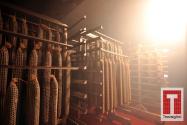
Anlagen für geräucherte Produkte
Bessere Steuerung der Fermentierung
Dank der Kombination von installierter Kälte- und Wärmeleistung ist es möglich, eine große Menge an gebundenem Wasser bei sehr niedrigen Kammertemperaturen aus den Produkten zu entfernen, besonders während der ersten Stunden des Fermentierungsprozesses. Auf diese Weise wird der aw -Wert (Wasseraktivität) gesenkt, die Fermentierung läuft kontrolliert ab und das Risiko einer Säuerung ist ausgeschlossen.
Geringere Belastung der Atmosphäre
Die Reduzierung der atmosphärischen Belastung wird durch ein programmierbares Rauch-Recycling-System im Inneren des Raumes, sowie durch einen Teerabscheider garantiert, der Teerpartikel aus dem Rauch filtert bevor sie in den Rauchraum gelangen.
In Option können unsere Anlagen außerdem mit einem By-Pass ausgestattet, welcher mittels eines Klappensystems verhindert, dass der Rauch durch den Klimaschrank strömt und dort die Register verschmutzt. Dadurch arbeiten die Anlagen effizienter und die Reinigungskosten für die Tauschregister sind deutlich geringer.
Weiterhin stehen in Option spezielle Filter/Luftreiniger zur Verfügung, die auf die Ausstoßkamine installiert werden und dessen Aufgabe darin besteht, die Umweltverschmutzung so gering wie möglich zu halten.
Gleichmäßigkeit im Gewichtsverlust
Die Luftverteilung innerhalb der Räume muss an allen Stellen so gleichmäßig wir möglich sein, um ein homogenes Produkt erhalten zu können.
Aus diesem Grand haben wir, auch dank der weitreichenden Erfahrungen, die wir im Laufe der Jahre sammeln konnten, je nach zur Anwendung kommender Art der Raumbeladung unterschiedliche Verteilersystem entwickel:
- der Anlagentyp „Turbo“, in dem die Luft über zwei seitlich an der Wand angebrachte Kanäle, die mit besonderen kegelstumpfförmigen Einspritzdüsen ausgestattet sind, zugeführt wird. Die Luftansaugung erfolgt über Deckenkanäle mit einstellbaren Ansaugdü Auch im Fall von Anlagen mit mehr als 4 Meter hohen Beladungen kann sowohl die Luftqualität (Temperatur und relative Feuchtigkeit) innerhalb der Räume dank eines in den Zufuhrkanal eingebauten Fühlers (Option) kontrolliert als auch ein System der Luftflussinversion benutzt werden, wobei die Ansaugkanäle auch zu Druckkanälen werden können und umgekehrt;
- anlagen mit Ringkanälen, in denen die Luftverteilung über kreisförmig angeordnete Zufuhrkanäle ausgeführt wird, die an der Raumdecke angebracht und mit jeweils entsprechend dimensionierten Löchern versehen sind. Die Luftansaugung kann entweder über Gitter erfolgen, die direkt an der Luftbehandlungseinheit (Klimaschrank) angebracht wurden oder auch über Kanäle, die über geeignete Ansauggitter verfügen;
- anlagen mit blasenden Wänden, in denen sowohl die Luftzufuhr als auch die Luftansaugung über zwei Diffusionswände ausgeführt werdendie ihrerseits von einer Luftbehandlungseinheit versorgt werden und wechselweise zur Luftzufuhr oder –ansaugung benutzt werden kö Auf diese Art und Weise wird das Produkt horizontal von einen zweckmäßigen Luftfluss erfasst.
Lufteinstellung
Das von der Firma Travaglini S.p.A. ausgearbeitete System besteht aus einem „T“-förmigen Kanal, in den ein Elektroantrieb eingebaut wurde, der die Bewegung der beiden Regelklappen mit entgegengesetzten Flügeln betreibt.
Im vergleich zu den einfachen und ungenaueren Systemen mit Flügelregelklappen und kreisförmigen Antrieb bietet die vorgenannte Lösung den Vorteil einer schrittweisen Modulation der Luftflüsse.
Außerdem ermöglicht ein Linearantrieb der neuen Generation (auch mit Encoder), der über eine programmierbare elektronische Leiterplatte gesteuert wird, wie folgt:
- einstellung jener Geschwindigkeit, mit der der Luftfluss den Raum in Querrichtung durchquert, dadurch kann das Produkt gleichmäßiger von der Luft erfasst werden;
- einstellung der Bewegungsgeschwindigkeit des Antriebs, dadurch kann die Luft korrekt und auf gleichmäßige Art und Weise den Einlasskanal füllen und somit die gleiche Luftmenge durch alle, d.h von der ersten bis zur letzten kegelförmigen Düse fließen;
- es ist die Möglichkeit gegeben, die Auslenkung des Antriebes einzustellen, um die Luftverteilung je nach Raumbreite optimieren zu können;
- es ist die Möglichkeit gegeben, eine oder mehrere Zwischenstopp des Luftflusses innerhalb des Raumes vornehmen zu lassen. Dies kann direkt von unserer elektronischen Steuerzentrale aus, die die gesamte Anlage betreibt, programmiert werden.
Reinigungssystem
Das automatische bzw. manuelle Reinigungssystem gestattet eine perfekte Reinigung des Lüfters, der Wechselklappe, des Abscheidefilters, der Zuluftkanäle (mit Reinigungsöffnungen) und der Ansaugkanäle (aufklappbar).
Computersystem
Unser computergestütztes System zur Steuerung und Verwaltung der Prozesse gestattet neben der Kontrolle der relativen Feuchtigkeit und Temperatur auch:
- die Eingabe vorgegebener Programme;
- kontrolle der Temperaturen aller Medien, um somit den Gewichtsverlust optimieren zu können;
- gleichzeitige Aufzeichnung und Wiedergabe der Kurvenverläufe verschiedener Variablen (Temperatur, relative Feuchtigkeit, usw.) auf nur einer Seite des Displays;
- Überprüfen der programmgemäßen Abläufe aller Reifezyklen.
Um die Überwachung mehrerer Anlagen von zentraler Stelle aus zu ermöglichen, haben wir eine spezielle Software entwickelt, welche die Überprüfung und Kontrolle aller Alarmmeldungen, Datenaufzeichnungen, grafischen Anzeigen, Fernüberwachung, Fernsteuerung und Fernwartung, sowie die automatische und zentralisierte Kontrolle der Räume für eine Verbauchsoptimierung zulässt.
Energieeinsparung
Wärmerückgewinnung: Unsere Systeme gestatten die komplette Wärmekondensation bei laufendem Kühlbetrieb eines Kältekompressors zu nutzen. Dies bedeutet, dass für die Nachheizung bei gleichzeitiger Kälteanforderung fast nie (nie im Fall von Brenn-bzw. Ruheanlagen) eine externe Wärmeversorgung erforderlich ist, wenn parallel der Kompressorbetrieb läuft.
Außerdem kann mit Hilfe eines Enthitzers (in Option zur Anlage) Warmwasser mit ca. 40 – 50 °C produziert werden, das daraufhin entweder für andere Prozessanlagen oder auch für andere Abnehmer im Werk genutzt werden kann.
Enthalpie: Dieses System nutzt so lang wie möglich die Trocknungskapazität der Außenluft, wenn es die äußeren Bedingungen gestatten. Unser System basiert auf einem Algorithmus, der die Außenluftnutzung auch dann gestattet, wenn einer der Parameter (Temperatur, rel. Luftfeuchtigkeit) sich anscheinend von den erforderlichen Sollwerten unterscheidet.
Economizer: In den Anlagen mit unabhängigen Kälteaggregaten wird eine zusätzliche Unterkühlung des Kältemittels gefahren, was die Effizienz der Kompressorleistung um mehr als 15 - 18% erhöht und dies bei gleichbleibender elektrischer Leistungsaufnahme.
Modulation (Ansteuerung) der Kälte- und Wärmeventile: um die Leistung der Anlage in Abhängigkeit der realen Bedürfnisse des jeweiligen Produktes während der unterschiedlichen Reifephasen verbessern zu können.
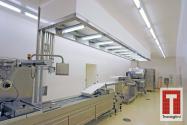
Anlagen für den Einsatz der Reinraumtechnik
Seit 1950 ist Travaglini S.p.A. einer der weltweit führenden Hersteller von Anlagen im Lebensmittelsektor, bestimmt für die Herstellung von Fleischerzeugnissen und Molkereiprodukten. Unser Unternehmen ist außerdem ein anerkannter Lieferant von Klima- und Aircondition-Anlagen, sowie klimatisierender Reinraumtechnik.
Dank der fundierten Kenntnisse und Erfahrungen mit den technologischen Prozessen und den damit verbundenen hygienischen Problemen sind wir in der Lage, ausgereifte Anlagen sowie das erforderliche Know-How als auch den Kundendienst zu liefern und somit mit geeigneten Lösungen auf die produktspezifischen Anforderungen unsere Kunden eingehen zu können.
Begriffsdefinition “Reinraum”
Reinräume nennt man jene Räume, in denen die Konzentration von luftübertragenen Partikeln kontrolliert wird. Diese Räume sind auf eine Art und Weise ausgeführt, dass die Einführung, die Erzeugung und der Erhalt schädlicher Partikel minimiert werden kann.
Die Kontamination von Produkten durch Staub, Schimmel und luftübertragene Partikel beeinträchtigt sowohl deren Qualität als auch die Haltbarkeit.
Ursachen von Verunreinigungen
Nachfolgend die wichtigsten Ursachen für die Kontamination der Luft:
- der Hauptverursacher von Infektionen ist der Mensch – eine kleine Bewegung setzt Millionen Partikel unterschiedlicher Größe frei;
- die Produkte, besonders wenn sie verpackt oder dem Staub ausgesetzt waren;
- die Maschinen für die Produktion und techn. Medien (Druckluftanlagen mit offenen Ablässen, Schmieröle, Kondenswassertropfen, Ablässe ohne Schächte etc.);
- die Produktionsprozesse, Reinigungs- und Desinfektionsprozesse;
- biologische Kontamination durch Pilzsporen, Hefen und Bakterien in der Luft.
Produktschutz
Die Produkte vor der Kontaminierung mit gefährlichen, luftübertragenen Partikel zu schützen, heißt den Kontakt mit der Luft selbst zu vermeiden.
Über sämtliche Prozessschritte ist dies jedoch nicht möglich bzw. extrem schwierig.
Allerdings kann der Schutz auf andere Art erfolgen: Anstatt das Produkt von seiner Umgebung zu isolieren, kann ein qualitativ hochwertiges Ambiente geschaffen werden, welches das Produkt umgibt. Dieses sind kontrollierte hygienische Bedingungen und besonders reine Luft, um so den Produktschutz deutlich zu erhöhen.
Reinraumklassifizierung
In der untenstehenden Tabelle wird die Klassifizierung der Luftreinheit (Filtrationsgrad) entsprechend dem Federal Standard 209 E, Federal Standard 290 D und der ISO 14644-1 aufgeführt, welche die Grundlage für Ermittlung der Reinheitsklasse darstellen.
Außerdem gelten seit der Einführung des Fed.Std.209D zur Feststellung der korrekten Ausführung eines Reinraumes die folgenden Testbedingungen für die Partikelmessung –
- nicht ausgerüsteter Reinraum (asbuilt)
- reinraum im Ruhezustand (atrest)
- reinraum in Betrieb (operational)
Filter
Für jede Klasse der Reinraumanlagen werden Filter mit unterschiedlichem Abscheidegrad verwendet.
Die Luftfiltration findet auf progressive Weise statt, das heißt: es wird stufenweise mit gröberen Filtern begonnen, die Luft zu reinigen, so dass am Ende der Kaskade die Filter mit der höchsten Reinheitsklasse stehen. Dies schützt die empfindlichen Ultrafilter vor Beschädigung und schneller Verunreinigung.
Eigenschaften der Arbeitsumgebung
- begrenzte Abmessungen um eine gesunde Arbeitsumgebung zu garantieren;
- arbeitsbereiche müssen soweit wie möglich von Kontaminationsquellen entfernt positioniert werden;
- der Produktionsfluss muss vom weniger sterilen Bereich zur höchsten Reinheitsstufe ablaufen;
- reduzierung/Eliminierung von Turbulenzen in den Reinräumen;
- einfacher Zugang zu allen Bereichen der Reinräume um einfach reinigen zu können;
- im Reinraum verwendetes Zubehör muss den internationalen Sicherheits- und Hygienevorschriften entsprechen.
Aufbau und Wirkungsweise eines Reinraumes
Ein grundlegendes Charakteristikum von Reinräumen ist, dass er oft in Bereiche mit begrenzten Platzverhältnissen eingeschlossen ist, um die Produktionsansprüche optimieren zu können. Die Luftverteilung innerhalb eines Reinraumes kann auf verschiedenen Wegen erfolgen, wodurch, verbunden mit den unterschiedlichen Filtrationsgraden, der Schutzgrad vor Kontamination der Produkte vorbestimmt wird.
Die folgenden unterschiedlichen Methoden der Luftverteilung sind möglich:
- einseitige vertikale Strömung, was bedeutet, dass die Filter an der Decke befestigt sind und die Rückführung der Luft aus dem unteren Bereich des Raumes oder durch einen perforierten doppelten Boden erfolgt (Abb. 1a). In diesem Fall ist der saubere Arbeitsbereich im oberen Teil des Raumes positioniert;
- einseitige horizontale Strömung, bei der die Luft aus wandmontierten Filtern einströmt und ihre Rückführung über Ansauggitter erfolgt. Der saubere Arbeitsbereich liegt zwischen den Filtern, welche die Strömung generieren, und der ersten Quelle der Kontamination aus (Abb. 1b);
- strömung in mehrere Richtungen,(Abb. 2a), die saubere Arbeitsluft ist das Rauminnere;
- kombinationsströmung, welche vorliegt, wenn einseitige- und Strömungen aus mehreren Richtungen gemeinsam auftreten (Abb. 2b).
Beim Betrachten dieser Einteilung wird klar, dass die Wahl der Filterposition maßgeblich für die Gestaltung des Reinraumes ist.
Umgebungsparameter in den Reinräumen
Die grundlegenden Parameter der Umgebung sind diejenigen, die unter Kontrolle zu halten sind, um eine hohe Produktqualität zu gewährleisten. Zusätzliches Augenmerk ist auf die Bereiche Verpackung, Abfall, Energieverbrauch, Funktionalität der Maschinen sowie Ergonomie für das Arbeitspersonal zu richten.
Diese Parameter sind:
- temperatur und Feuchtigkeit: Die Kontrolle der relativen Luftfeuchtigkeit, die von grundlegender Bedeutung für die Produktqualität ist, hat darüber hinaus noch große Bedeutung hinsichtlich der Gefahr von Korrosion, Kondensatbildung auf den Oberflächen, sowie die Verringerung der elektrostatischen Aufladung;
- druckunterschied: Alle Räume müssen einen höheren statischen Druck aufweisen als der anliegende atmosphärische Druck, um jegliche Art von Kontamination vermeiden zu kö Jeder Luftausstoß aus den Räumen muss durch die Immission neuer Luft ausgeglichen werden, um den Umgebungsdruck unverändert halten zu können;
- beleuchtung: Die Intensität, und Gleichmäßigkeit der Beleuchtung sowie die Farbe des Lichtes müssen überprüft werden;
- geräusche und Vibrationen können durch ihre Einwirkung sowohl gefährlich für das Personal als auch für die Anlagen selbst sein.
Verbindung zwischen den verschiedenen Arbeitsbereichen
- öffnungen zwischen den Bereichen mit kontrollierter Atmosphäre müssen auf ein Mindestmaß begrenzt sein;
- ein- und Ausgänge müssen mit „Luftschleieranlagen“ versehen sein, um Kontaminationen auf das Äußerste zu minimieren, darüber hinaus ist eine ständige Druckdifferenz zwischen den verschiedenen Arbeitsbereichen aufrecht zu erhalten.
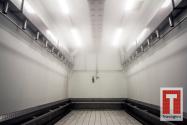
Auftauanlagen
Seit dem Jahre 1950 ist Travaglini S.p.A. führend in der Herstellung und Entwicklung von Auftauanlagen für alle Arten von Fleisch und Fleischprodukten, sowie verschiedenster Fischerzeugnisse.
Während des gesamten Auftauzyklus, der in Abhängigkeit der Produktabmessungen zwischen 12 und 36 Stunden andauern kann, können wir eine perfekte Gleichmäßigkeit der Temperatur an allen Stellen des Raumes mit einem sehr geringen Gewichtsverlust gewährleisten.
Die Vorteile unserer Anlagen:
- klimaschrank, Heiz- und Kühlregister, Ventilator, Luftzufuhr- und Luftansaugkanäle aus Edelstahl;
- ein Mikroprozessor kontrolliert den Betrieb der Anlage mittels Temperatur- und Luftfeuchtigkeitsfühler im Raum sowie Fühler im Produkt (Oberfläche und Kern). Die Letztgenannten werden in das Produkt eingeführt, um in Realzeit die Temperatur unter sich ändernden Raumbedingungen auf dem Monitor verfolgen zu können und demzufolge den Betrieb der Anlage neu einstellen zu können;
- heizungs- und Befeuchtungssystem mit Sattdampf für eine bessere Effizienz und einen größeren Wärmeübergangskoeffizienten bei der Wärmeübertragung auf das Produkt mit hoher Gleichmäßigkeit;
- konstante mikrobielle Belastung Dank des Einsatzes von Dampf im Raum;
- mikrobiologische Produktsicherheit und Hygiene während des Prozesses garantieren eine lange Haltbarkeit
- einstellbare Raumtemperatur von -5 bis +20°C und rel. Luftfeuchtigkeit bis 95% - 100%;
- die Anlage arbeitet am Zyklusende auch als Kühlzelle, um die aufgetauten Produkte bis zur Verarbeitung kalt zu halten;
- geringerer Gewichtsverlust im Vergleich zu anderen Auftauensystemen;
- geringer Verlust an wertvollen Proteinen;
- geringe Energiekosten;
- hohe Ladekapazität (mehr als 1000 kg/m²)
- vermeidung aller Nachteile der herkömmlichen Auftaumethoden mit Kaltwasser, wie das Eindringen von Wasser in das Rohmaterial, enorm hoher Wasserverbrauch und Abfluss von Schmutzwasser in die Abwasserkanalisation.
Gleichmäßiger Gewichtsverlust
Im Anlagentyp “Turbo” wird die Luftverteilung über zwei an den Seitenwänden angebrachte Kanäle, die speziell dimensioniert und mit konischen Luftdüsen ausgestattet sind, ausgeführt. Ein Linearantrieb bewegt die Regelklappen im Inneren der Lufteinlasskanäle und garantiert somit eine sich ständig hin- und her bewegende Luftwalze im Raum. Über Deckenkanäle mit einstellbaren Ansaugdüsen wird die Prozessluft wieder dem Klimaschrank zugeführt.
Computersystem
Unser computergestütztes System zur Steuerung und Verwaltung der Prozesse gestattet die Kontrolle sämtlicher Prozessparameter wie:
- die Eingabe vorgegebener Programme;
- kontrolle der Temperaturen aller Medien, um somit den Gewichtsverlust optimieren zu können;
- gleichzeitige Aufzeichnung und Wiedergabe der Kurvenverläufe verschiedener Variablen (Temperatur, relative Feuchtigkeit, usw.) auf nur einer Seite des Displays;
- überprüfen der programmgemäßen Abläufe aller Auftauzyklen.
Um die Überwachung mehrerer Anlagen von zentraler Stelle aus zu ermöglichen, haben wir eine spezielle Software entwickelt, welche die Überprüfung und Kontrolle aller Alarmmeldungen, Datenaufzeichnungen, grafischen Anzeigen, Fernüberwachung, Fernsteuerung und Fernwartung, sowie die automatische und zentralisierte Kontrolle der Räume für eine Verbauchsoptimierung zulässt.
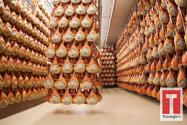
Anlagen für das Salzen, Brennen, Fermentieren (Trocknen) und Reifen von Rohschinken
Seit dem Jahr 1950 ist Travaglini S.p.A. führend in der Entwicklung von Salzräumen und Brennräumen, sowie von Vor- und Nachreiferäumen für die Rohschinkenproduktion und dies vor allem dank den Erfahrungen, die wir während unserer langjährigen Zusammenarbeit mit den weltweit bekanntesten Schinkenproduzenten sammeln konnten.
Die von uns entwickelten Technologien, verbunden mit der hohen Fachkenntnis unserer Spezialisten, können unseren Kunden dabei helfen, all jene Probleme zu lösen, die mit der Herstellung geräucherter bzw. luftgetrockneter Rohschinkenprodukte verbunden sind, unabhängig von der jeweiligen spezifischen Anwendung.
Dies sind im Besonderen:
Salzraum
Die Anlagen bestehen aus statischen Kälteverdampfern (deckenmontiert) und Heizungskonvektoren, die von einem mit Warmwasser betriebenen Register versorgt werden, das in der Mitte oder an den Seitenwänden des Raumes eingebaut wird.
Als Alternative zur oben genannten Lösung mit statischen Kälteverdampfern kann in einigen Fällen ein System der ventilierten Salzung angewandt werden, das den Einsatz besonderer runder Kanäle sowie einer Luftbehandlungseinheit vorsieht.
Die Kontrolle von Temperatur und Luftfeuchtigkeit ist unumgänglich für eine gute Absorption der Salzmoleküle. Die Salzphase variiert in der Zeitdauer von 10 bis 21 Tagen, in Abhängigkeit vom Rohgewichte der Schinken.
Vorbrennen (Vorruhe)
Wir haben ein revolutionäres System der Belüftung für diesen Anlagentyp entwickelt. Die Luft wird über längsseitig angeordnete Kanäle zugeführt, die an der Wand abgehängt sind. Die Kanäle sind mit speziell geformten konischen Luftaustrittsdüsen versehen.
Ein Linearantrieb bewegt Luftklappen in den Lufteinblaskanälen, die dafür sorgen, dass eine konstant bewegte Luftwalze auch die kritischen Bereiche innerhalb des Raumes erreicht und somit für ein besseres Trocknungsergebnis gewährleistet. Dies ist möglich, da die Luftwalze gezielt auf die kritischen Bereiche programmiert werden kann und die erforderliche Luft dorthin geleitet wird, wo sie benötigt wird. Es können Positionen für Zwischenstopps sowie die Dauer dieser Stopps vorgesehen werden. Die Luftansaugung erfolgt über deckenmontierte Rückluftkanäle, die mit einstellbaren Ansaugöffnungen ausgerüstet sind.
Diese Art von Anlagen ist dafür ausgelegt , unter sehr geringer Luftfeuchtigkeit zu arbeiten, um die Schinkenrohlinge bei äußerst kühlen Temperaturen zu trocknen. Dadurch wird die Aktivität der Bakterien gehemmt und das Eindringen des Salzes in den Kern der Schinken unterstützt.
Dies ist der empfindlichste und gleichzeitig wichtigste Schritt im Rohschinkenprozess. Die Periode des Vorbrennens (Vorruhe) dauert ca. 2 bis 3 Wochen, entsprechend der Art des jeweiligen Schinkens.
Brennen (Ruhe)
Dieser Anlagentyp ist insbesondere dafür ausgelegt, bei niedriger relativer Luftfeuchtigkeit eine allmähliche Abtrocknung des Produktes unter Vermeidung des Trockenrandes zu erreichen. Die Brennphase liegt zwischen 5 und 12 Wochen, abhängig vom Schinkentyp.
Fermentierung (Trocknung)
Diese Phase dauert ca. 1-2 Wochen und ermöglicht durch Erhöhung der Kerntemperatur des Produktes den Beginn enzymatischer Prozesse.
Vorreifung
Dieser Prozessabschnitt benötigt ca. 3 bis 12 Wochen und erlaubt eine weitere Abtrocknung des Rohschinkens, um eine sichere Haltbarkeit des Produktes zu gewährleisten.
Reifung / Nachreife
Die Reifeanlagen sind so ausgelegt, dass sie die Temperatur und Luftfeuchtigkeit in einer Weise steuern, dass es dem Produkt möglich gemacht wird, sein typisches Aroma und seinen eigenen Geschmack zu entwickeln.
Computersystem
Unser computergestütztes System zur Steuerung und Verwaltung der Prozesse gestattet neben der Kontrolle der relativen Feuchtigkeit und Temperatur auch:
- die Eingabe vorgegebener Programme;
- kontrolle der Temperaturen aller Medien, um somit den Gewichtsverlust optimieren zu können;
- gleichzeitige Aufzeichnung und Wiedergabe der Kurvenverläufe verschiedener Variablen (Temperatur, relative Feuchtigkeit, usw.) auf nur einer Seite des Displays;
- überprüfen der programmgemäßen Abläufe aller Reifezyklen.
Um die Überwachung mehrerer Anlagen von zentraler Stelle aus zu ermöglichen, haben wir eine spezielle Software entwickelt, welche die Überprüfung und Kontrolle aller Alarmmeldungen, Datenaufzeichnungen, grafischen Anzeigen, Fernüberwachung, Fernsteuerung und Fernwartung, sowie die automatische und zentralisierte Kontrolle der Räume für eine Verbauchsoptimierung zulässt.
Energieeinsparung
Wärmerückgewinnung: Unsere Systeme gestatten die komplette Wärmekondensation bei laufendem Kühlbetrieb eines Kältekompressors zu nutzen. Dies bedeutet, dass für die Nachheizung bei gleichzeitiger Kälteanforderung fast nie (nie im Fall von Brenn-bzw. Ruheanlagen) eine externe Wärmeversorgung erforderlich ist, wenn parallel der Kompressorbetrieb läuft.
Außerdem kann mit Hilfe eines Enthitzers (in Option zur Anlage) Warmwasser mit ca. 40 – 50 °C produziert werden, das daraufhin entweder für andere Prozessanlagen oder auch für andere Abnehmer im Werk genutzt werden kann.
Enthalpie: Dieses System nutzt so lang wie möglich die Trocknungskapazität der Außenluft, wenn es die äußeren Bedingungen gestatten. Unser System basiert auf einem Algorithmus, der die Außenluftnutzung auch dann gestattet, wenn einer der Parameter (Temperatur, rel. Luftfeuchtigkeit) sich anscheinend von den erforderlichen Sollwerten unterscheidet.
Economizer: In den Anlagen mit unabhängigen Kälteaggregaten wird eine zusätzliche Unterkühlung des Kältemittels gefahren, was die Effizienz der Kompressorleistung um mehr als 15 - 18% erhöht und dies bei gleichbleibender elektrischer Leistungsaufnahme.
Effizienzoptimierte Motoren (IE2 – IE3): sie erhöhen die Leistung der Anlage bei gleichzeitiger Senkung des Energieverbrauchs.
Inverter: hierbei handelt es sich um Frequenzregler, die auf die Elektromotoren der Zentrifugalventilatoren und/oder auf die Kompressoren installiert werden und deren Drehzahlen erhöhen oder verringern, wodurch im Fall von Veränderungen der Prozessbedingungen und der Beladung die Effizienz der Motoren bzw. Kompressoren optimiert werden kann.
direkte Kopplung Motor/Ventilator: diese besondere technische Lösung, verbunden mit dem Einsatz eines Inverters, ermöglicht eine Senkung des Energieverbrauches der Anlage und optimiert dessen Einstellung.
Modulation (Ansteuerung) der Kälte- und Wärmeventile: um die Leistung der Anlage in Abhängigkeit der realen Bedürfnisse des jeweiligen Produktes während der unterschiedlichen Reifephasen verbessern zu können.
Enteisungssystem mit Heißgas: damit kann das Kühlregister besser und in kürzerer Zeit enteist werden, was eine bedeutende Energieeinsparung mit sich bringt.

Trocknungs- und Reifeanlagen für Rohwurst
Seit dem Jahre 1950 ist Travaglini S.p.A. führend in der Herstellung innovativer Anlagen für das Fermentieren (Trocknen), Räuchern und Reifen von Fleischprodukten, nicht zuletzt dank der Erfahrungen, die wir in enger Zusammenarbeit mit den bekanntesten Rohwurstproduzenten auf der ganzen Welt sammeln konnten.
Die von uns entwickelten Technologien, verbunden mit der hohen Fachkenntnis unserer Spezialisten, können unseren Kunden dabei helfen, all jene Probleme zu lösen, die mit der Herstellung geräucherter bzw. luftgetrockneter Produkte verbunden sind, unabhängig von der jeweiligen spezifischen Anwendung.
Dies sind im Besonderen:
Bessere Steuerung der Fermentierung (Trocknung)
Dank der Kombination von installierter Kälte- und Wärmeleistung ist es möglich, eine große Menge an gebundenem Wasser bei sehr niedrigen Raumtemperaturen aus den Produkten zu entfernen, besonders während der ersten Stunden des Fermentierungsprozesses. Auf diese Weise wird der aw-Wert (Wasseraktivität) gesenkt, die Fermentierung läuft kontrolliert ab und das Risiko eine Säuerung ist ausgeschlossen.
Minimierung der Gefahr des Trockenrandes
Die Gefahr der Ausbildung eines Trockenrandes wird mit unseren Anlagen praktisch vermieden, da die Steuerung der Anlage über jene Feuchtigkeit erfolgt, die aus den Produkten nach außen tritt. Während der einzelnen Reifephasen ist die Prozesszeit in immer wiederkehrende Pausenzeiten aufgeteilt, die den Austritt der Wassermoleküle aus dem Kern bis zur Oberfläche des Produkt gestatten.
Gleichmäßigkeit im Gewichtsverlust
Die Luftverteilung innerhalb der Räume muss an allen Stellen so gleichmäßig wir möglich sein, um ein homogenes Produkt erhalten zu können.
Aus diesem Grund haben wir, auch dank der weitreichenden Erfahrungen, die wir im Laufe der Jahre sammeln konnten, je nach zur Anwendung kommender Art der Raumbeladung unterschiedliche Verteilersystem entwickel:
- der Anlagentyp „Turbo“, in dem die Luft über zwei seitlich an der Wand angebrachte Kanäle, die mit besonderen kegelstumpfförmigen Einspritzdüsen ausgestattet sind, zugeführt wird. Die Luftansaugung erfolgt über Deckenkanäle mit einstellbaren Ansaugdü Auch im Fall von Anlagen mit mehr als 4 Meter hohen Beladungen kann sowohl die Luftqualität (Temperatur und relative Feuchtigkeit) innerhalb der Räume dank eines in den Zufuhrkanal eingebauten Fühlers (Option) kontrolliert als auch ein System der Luftflussinversion benutzt werden, wobei die Ansaugkanäle auch zu Druckkanälen werden können und umgekehrt;
- anlagen mit runden Kanälen, in denen die Luftverteilung über Zufuhrkanäle mit rundem Querschnitt ausgeführt wird und die an der Raumdecke angebracht und mit jeweils entsprechend dimensionierten Löchern versehen sind. Die Luftansaugung kann entweder über Gitter erfolgen, die direkt an der Luftbehandlungseinheit (Klimaschrank) angebracht wurden oder auch über Kanäle, die über geeignete Ansauggitter verfügen;
- anlagen mit blasenden Wänden, in denen sowohl die Luftzufuhr als auch die Luftansaugung über zwei Diffusionswände ausgeführt werden, die ihrerseits von einer Luftbehandlungseinheit versorgt werden und wechselweise zur Luftzufuhr oder –ansaugung benutzt werden kö Auf diese Art und Weise wird das Produkt horizontal von einen zweckgemäßen Luftfluss erfasst.
Lufteinstellung
Das von der Firma Travaglini S.p.A. ausgearbeitete System besteht aus einem „T“-förmigen Kanal, in den ein Elektroantrieb eingebaut wurde, der die Bewegung der beiden Regelklappen mit entgegengesetzten Flügeln betreibt.
Im Vergleich zu den einfachen und ungenaueren Systemen mit Flügelregelklappen und rundem Antrieb bietet die vorgenannte Lösung den Vorteil einer schrittweisen Modulation der Luftflüsse.
Außerdem ermöglicht ein Linearantrieb der neuen Generation (auch mit Encoder), der über eine programmierbare elektronische Leiterplatte gesteuert wird, wie folgt
- einstellung jener Geschwindigkeit, mit der der Luftfluss den Raum in Querrichtung durchquert, dadurch kann das Produkt gleichmäßiger von der Luft erfasst werden;
- einstellung der Bewegungsgeschwindigkeit des Antriebs, dadurch kann die Luft korrekt und auf gleichmäßige Art und Weise den Einlasskanal füllen und somit die gleiche Luftmenge durch alle, d.h. von der ersten bis zur letzten kegelförmigen Düse fließen;
- es ist die Möglichkeit gegeben, die Auslenkung des Antriebes einzustellen, um die Luftverteilung je nach Raumbreite optimieren zu können;
- es ist die Möglichkeit gegeben, eine oder mehrere Zwischenstopp des Luftflusses innerhalb des Raumes vornehmen zu lassen. Dies kann direkt von unserer elektronischen Steuerzentrale aus, die die gesamte Anlage betreibt, programmiert werden.
Energieeinsparung
Wärmerückgewinnung: Unsere Systeme gestatten die komplette Wärmekondensation bei laufendem Kühlbetrieb eines Kältekompressors zu nutzen. Dies bedeutet, dass für die Nachheizung bei Kälteanforderung keine externe Wärmeversorgung erforderlich ist, wenn parallel der Kompressorbetrieb läuft.
Außerdem kann mit Hilfe eines Enthitzers (in Option zur Anlage) Warmwasser mit ca. 40 – 50 °C produziert werden, das daraufhin entweder für andere Prozessanlagen oder auch für andere Abnehmer im Werk genutzt werden kann.
Enthalpie: Dieses System nutzt so lang wie möglich die Trocknungskapazität der Außenluft, wenn es die äußeren Bedingungen gestatten. Unser System basiert auf einem Algorithmus, der die Außenluftnutzung auch dann gestattet, wenn einer der Parameter (Temperatur, rel. Luftfeuchtigkeit) sich anscheinend von den erforderlichen Sollwerten unterscheidet.
Economizer: In den Anlagen mit unabhängigen Kälteaggregaten wird eine zusätzliche Unterkühlung des Kältemittels gefahren, was die Effizienz der Kompressorleistung um mehr als 15 - 18% erhöht und dies bei gleichbleibender elektrischer Leistungsaufnahme.
Effizienzoptimierte Motoren (IE2 – IE3): sie erhöhen die Leistung der Anlage bei gleichzeitiger Senkung des Energieverbrauchs.
Inverter: hierbei handelt es sich um Frequenzregler, die auf die Elektromotoren der Zentrifugalventilatoren und/oder auf die Kompressoren installiert werden und deren Drehzahlen erhöhen oder verringern, wodurch im Fall von Veränderungen der Prozessbedingungen und der Beladung die Effizienz der Motoren bzw. Kompressoren optimiert werden kann.
direkte Kopplung Motor/Ventilator: diese besondere technische Lösung, verbunden mit dem Einsatz eines Inverters, ermöglicht eine Senkung des Energieverbrauches der Anlage und optimiert dessen Einstellung.
Modulation (Ansteuerung) der Kälte- und Wärmeventile: um die Leistung der Anlage in Abhängigkeit der realen Bedürfnisse des jeweiligen Produktes während der unterschiedlichen Reifephasen verbessern zu können.
Enteisungssystem mit Heißgas: damit kann das Kühlregister besser und in kürzerer Zeit enteist werden, was eine bedeutende Energieeinsparung mit sich bringt.




